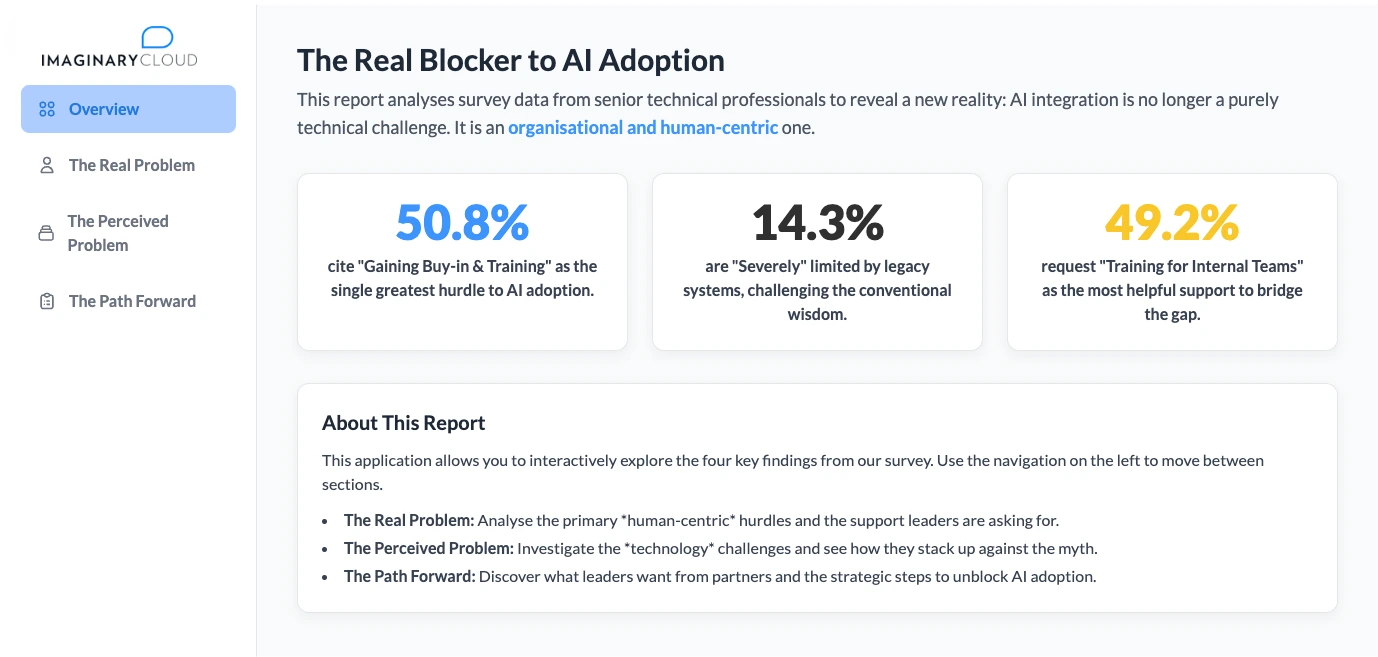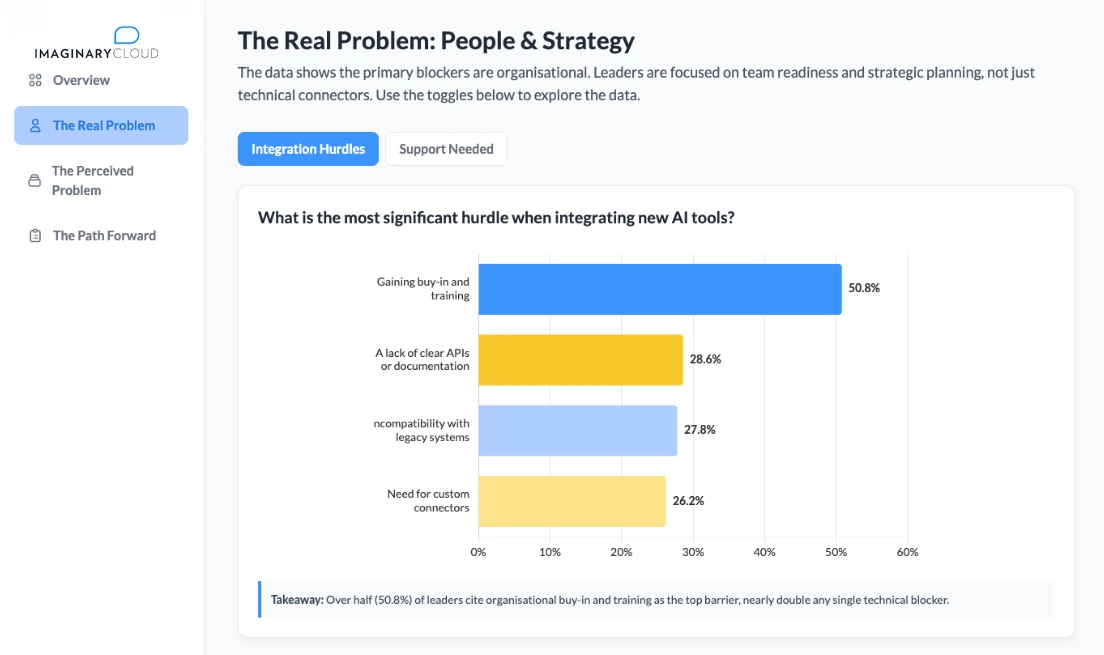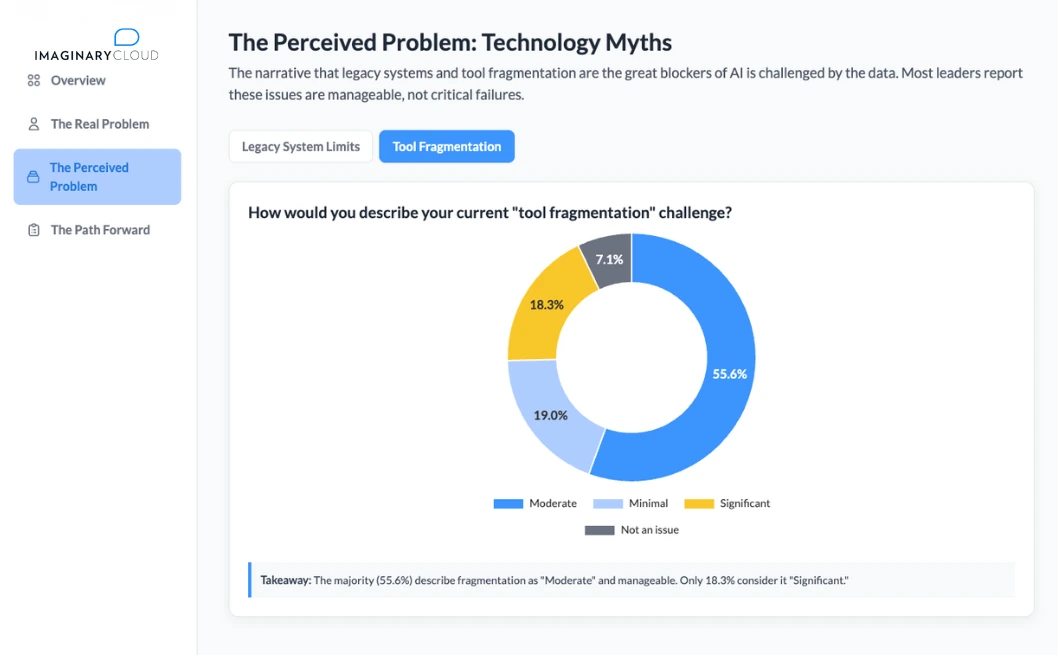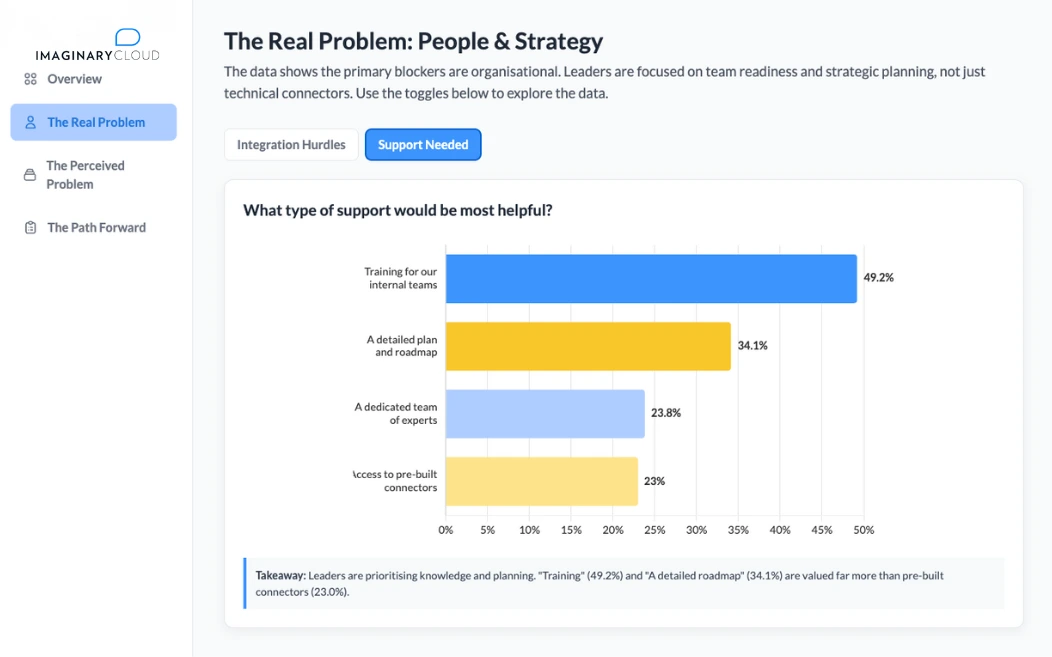contact us


AI adoption is the defining challenge for today's tech professionals. Countless projects, backed by significant investment, stall or fail to deliver value. The common culprits are always the same: clunky legacy systems, complex technical integrations, or a fragmented toolchain.
But what if the accepted wisdom is wrong? What is the real, underlying hurdle that blindsides so many teams? This article answers that question, using exclusive data from our 2025 Berlin survey of senior tech professionals to reveal the true bottleneck to successful AI integration.
Our exclusive survey, conducted in Berlin in November 2025 with senior tech professionals, delivers a clear verdict on stalled AI adoption: the problem isn't the technology. The data shows the single biggest hurdle, cited by 51% of leaders, is gaining organisational buy-in and training.
This "people problem" was named almost twice as often as technical blockers like custom engineering effort (26%) and legacy systems (14%). While most conversations focus on hardware and software, our data reveals the true bottleneck is human.

Organisational buy-in is the process of aligning stakeholders and teams to support a new technology or strategic direction, crucial for successful AI implementation.
Our survey found this to be the paramount challenge for over half of tech leaders (51%). This figure dwarfs concerns about technical blockers, highlighting that people-centric issues like fear of change, lack of understanding, and insufficient training are far more critical than system limitations.
A 2023 report by McKinsey & Company similarly underlines the importance of organisational change management in successful technology adoption. Overcoming these human elements is the first step towards an enterprise AI integration strategy.

Legacy systems are outdated platforms often perceived as the main blockers to modernisation. However, survey data suggests strategic integration, not the system itself, is the core issue for AI. Countering widespread belief, only 14% of leaders reported being severely blocked by legacy systems.
This data reframes the problem: it’s not the existence of older systems, but rather the lack of a strategic integration plan to connect them with modern AI solutions. A phased, intelligent approach to strategic AI modernisation can transform these perceived roadblocks into pathways for innovation, as opposed to costly full-scale replacements.

Tool fragmentation is a state where multiple, disconnected AI tools create workflow inefficiencies, often stemming from a lack of overarching strategic guidance rather than inherent technical flaws. Our survey revealed that 56% of tech leaders view this as "moderate but manageable."
This suggests that while inconvenient, tool fragmentation isn't the core problem, but rather a symptom of missing centralisation and governance. A strong AI integration strategy can unify disparate tools, transforming them from distractions into cohesive assets.

Key Takeaway: Our Berlin 2025 survey data unequivocally show that successful AI adoption hinges on addressing people-centric challenges and strategic foresight, not merely technical limitations.

Beyond identifying challenges, our survey data also illuminates the precise solutions and strategic support that tech leaders most urgently require for effective AI integration. These insights provide a clear, data-backed roadmap to overcoming AI adoption challenges and accelerating your journey from "before" (pain points) to "after" (tangible benefits).
An effective AI integration strategy is crucial because it provides a clear roadmap, aligns technology with business goals, and ensures stakeholder buy-in, as validated by tech leaders requesting strategic partnership.
The #1 need from external partners, according to 43% of our respondents, is "A strategic partner to help us define our future-proof tech stack." This highlights a demand for strategic guidance over simply selling tools. An AI Readiness Assessment is vital to identify specific use cases, evaluate existing infrastructure, and develop a comprehensive roadmap, ensuring that AI initiatives align with broader business objectives and ethical considerations, a key theme often discussed by MIT Technology Review.

Gaining buy-in for AI involves comprehensive team training and enablement, addressing fears, demonstrating benefits, and fostering a culture of adoption, which our survey reveals as the top requested support. Since 51% of leaders cited organisational buy-in and training as their biggest challenge, it's no surprise that 49% identified "Training for our internal teams" as the #1 most requested support.
Effective team enablement involves technical upskilling and it addresses change management, communicates the vision, and demonstrates how AI tools can augment, not replace, human capabilities. Programmes focused on practical application and ongoing support are key to fostering an AI-ready culture.

Our phased modernisation approach systematically tackles technical debt and integrates AI into core systems, ensuring a scalable and resilient infrastructure.
For the 14% of leaders severely blocked by legacy systems, the solution isn't always complete replacement. Instead, a strategic AI modernisation approach focuses on intelligent integration. This involves creating robust API layers, microservices architectures, and data orchestration platforms that allow AI to interoperate with existing systems without disrupting critical operations.
This phased strategy ensures minimal downtime, mitigates risk, and builds a future-proof tech stack that can evolve with emerging AI technologies.
To validate our findings, it's important to know who responded. The survey audience primarily consists of senior engineering leadership. While roles like Engineering Manager (31%) and Team Lead (12%) are well-represented, the largest single group (42%) falls under "Other."
This category includes a high concentration of senior-level titles such as CTO, Head of Data, Architect, and Principal Engineer, confirming that these insights come directly from strategic decision-makers.

Key Takeaway: Our data-driven insights confirm that strategic partnerships, comprehensive team enablement, and a phased modernisation approach are essential for turning AI adoption challenges into tangible success.
Imaginary Cloud’s proven services are structured to guide organisations from AI adoption challenges to successful, scalable integration. Our approach, combining strategic Product Scoping, AI Development, and Legacy Modernisation, directly addresses the pain points identified in our exclusive report.
The first step is to establish a solid strategic foundation with our Scoping Session service. This phase directly answers the 34% of tech leaders who need a "detailed plan and roadmap."
We conduct a thorough analysis of your business objectives, data infrastructure, and existing toolchain to define clear goals, identify high-impact AI use cases, and outline a realistic implementation timeline.
This strategic roadmap ensures your AI initiatives align with your business goals, mitigating the risks of ad hoc implementations.
Next, we tackle the technical hurdles with our Legacy System Modernisation service. This is the direct solution for the 14.% of leaders severely blocked by legacy systems.
Our strategy focuses on integrating AI components incrementally into your existing infrastructure. This involves carefully refactoring technical debt, building secure and scalable data pipelines, and implementing robust CI/CD pipeline integration for AI models.
This phased rollout minimises disruption and provides quick wins, demonstrating value early.
Finally, we address the #1 challenge (51% - organisational buy-in) by building the right solution. Our AI Development services focus on creating user-centric tools that integrate seamlessly into your team's existing workflows.
This human-centric approach is the key to solving the "people problem." Instead of forcing teams to adopt complex new software, we build intuitive solutions that augment their capabilities. This demonstrates value immediately, transforming resistance into enthusiastic adoption and ensuring the long-term success of your AI investments.
Key Takeaway: By following a structured path, strategic Scoping Session, Phased Modernisation, and human-centric AI Development, organisations can systematically overcome AI adoption hurdles and achieve sustainable integration.
The insights from our Berlin 2025 survey offer a compelling reframe of the AI adoption narrative. Rather than getting bogged down in perceived technical limitations, the real focus for enterprises seeking to harness AI's power should be on fostering organisational buy-in, strategic planning, and comprehensive team enablement.
Addressing these human and strategic elements head-on is the most effective way to build a future-proof tech stack and achieve transformative results with AI.
Ready to transform your AI aspirations into reality? Contact us and discover our AI solutions today.
An exclusive report by Imaginary Cloud, based on the 2025 Berlin survey of senior tech leaders, found that the biggest hurdle (50.8%) to AI adoption is gaining organisational buy-in and training. This was cited almost twice as often as technical blockers like legacy systems (14.3%) or custom engineering effort (26.2%).
Legacy systems are outdated platforms often perceived as the main blockers to modernisation; however, survey data shows only 14.3% of tech leaders are severely blocked by them. The true challenge lies in the lack of a strategic integration plan, not in the systems themselves.
AI tool fragmentation occurs when multiple, disconnected AI tools create workflow inefficiencies. Our survey reveals that 55.6% of leaders find this 'Moderate but manageable,' suggesting it's a symptom of a missing central strategy rather than a core technical disease.
Gaining buy-in for AI primarily involves comprehensive team training and enablement, addressing fears, demonstrating clear benefits, and fostering a culture of adoption. Our survey indicates that 'Training for our internal teams' (49.2%) is the #1 most requested support.
An AI integration strategy is a comprehensive plan that aligns AI initiatives with overall business objectives, addresses technical and human challenges, and provides a clear roadmap for successful AI adoption. Survey data shows that 'A strategic partner to help us define our future-proof tech stack' (42.9%) is the #1 need from external partners.
.webp)

Alexandra Mendes is a Senior Growth Specialist at Imaginary Cloud with 3+ years of experience writing about software development, AI, and digital transformation. After completing a frontend development course, Alexandra picked up some hands-on coding skills and now works closely with technical teams. Passionate about how new technologies shape business and society, Alexandra enjoys turning complex topics into clear, helpful content for decision-makers.
People who read this post, also found these interesting: